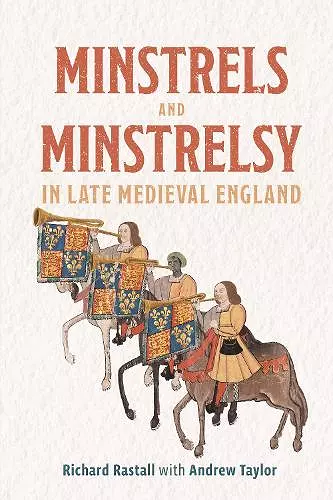Minstrels and Minstrelsy in Late Medieval England
Andrew Taylor author Richard Rastall author
Format:Paperback
Publisher:Boydell & Brewer Ltd
Published:4th Mar '25
Should be back in stock very soon
This paperback is available in another edition too:
- Hardback£110.00(9781837650392)

A major new study piecing together the intriguing but fragmentary evidence surrounding the lives of minstrels to highlight how these seemingly peripheral figures were keenly involved with all aspects of late medieval communities. Minstrels were a common sight and sound in the late Middle Ages. Aristocrats, knights and ladies heard them on great occasions (such as Edward I's wedding feast for his daughter Elizabeth in 1296) and in quieter moments in their chambers; town-dwellers heard and saw them in civic processions (when their sound drew attention to the spectacle); and even in the countryside people heard them at weddings, church-ales and other parish celebrations. But who were the minstrels, and what did they do? How did they live, and how easily did they make a living? How did they perform, and in what conditions? The evidence is intriguing but fragmentary, including literary and iconographic sources and, most importantly, the financial records of royal and aristocratic households and of towns. These offer many insights, although they are often hard to fit into any coherent picture of the minstrels' lives and their place in society. It is easy to see the minstrels as peripheral figures, entertainers who had no central place in the medieval world. Yet they were full members of it, interacting with the ordinary people around them, as well as with the ruling classes: carrying letters and important verbal messages, some lending huge sums of money to the king (to finance Henry V's Agincourt campaign in 1415, for instance), some regular and necessary civic servants, some committing crimes or suffering the crimes of others. In this book Rastall and Taylor bring to bear the available evidence to enlarge and enrich our view of the minstrel in late medieval society.
Rastall and Taylor contribute to the continuing efforts to move away from romanticized images of the Middle Ages peddled by modern myth. In doing so they reveal just how little we concretely know about medieval minstrelsy, but cement its study as a fascinating window through which we can gain a deeper understanding of the people and culture of late medieval England. * TIMES LITERARY SUPPLEMENT *
Minstrels and Minstrelsy is testament to Rastall's lifelong dedication to the study of this topic. Rastall and Taylor have gathered and presented a wealth of evidence with skill and nuance, and have reached honest conclusions. This book greatly increases our understanding of the day-to-day lives of minstrels. * EARLY MUSIC *
This excellent book is not only about exploding myths, but also about a careful reassessment of the evidence available. This book is highly recommended for anyone who wishes to delve into medieval music-making. * FOLK MUSIC JOURNAL *
This welcome study, both detailed and comprehensive, surveys the current state of the field and demonstrates that minstrel performers played a more significant role in late medieval English society than is often recognized. * JOURNAL OF BRITISH STUDES *
Rastall and Taylor remind the reader that much remains to be done to expand their account, but the book is certainly an impressive consolidation of research undertaken by these authors and others before them, and is written with the confidence and clarity of those who have spent a considerable proportion of their careers documenting minstrelsy and other musical practices. * MUSIC & LETTERS *
In short, this volume sets out what we know and what we still need to work out, presenting this material in an engaging and precise manner. Its utility as a reference tool cannot be overstated, but most of all it is an engaging and stimulating read for anyone interested in the period. * SPECULUM *
ISBN: 9781837652556
Dimensions: unknown
Weight: 666g
476 pages